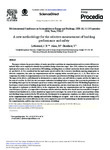A New Methodology for the Selective Measurement of building Performance and Safety
| dc.contributor.author | Littlewood, JR | |
| dc.contributor.author | Alam, M | |
| dc.contributor.author | Goodhew, Steve | |
| dc.date.accessioned | 2018-07-30T10:07:11Z | |
| dc.date.available | 2018-07-30T10:07:11Z | |
| dc.date.issued | 2017-03 | |
| dc.identifier.issn | 1876-6102 | |
| dc.identifier.uri | http://hdl.handle.net/10026.1/11945 | |
| dc.description.abstract |
This paper evaluates the present evidence of smoke spread due to problems in compartmentation and also reviews different test methods which can be employed to identify these problems during construction stages. Since 2010, evidence has emerged that the rapid spread of smoke occurs in and between UK buildings, including where accredited construction details and/or robust details are specified [1,2]. It is considered that this rapid smoke spread could be due to incorrect installation, missing, inappropriate or defective components, that make up compartmentation and fire stopping within concealed spaces [1-3]. These defects can compromise the ability of compartmentation to resist fire and smoke spread between dwellings and also into any means of escape. The impact of the defects could ultimately be detrimental to occupant safety, care staff with the occupants and also fire fighters, in the event of a real fire. In 2016, fire risk assessments undertaken in buildings before occupancy (that ascertain the performance of the building with respect to fire and smoke spread in accordance with Approved Document B) of the UK Building Regulations are based upon a visual review of building design details and documentation, and also visual inspection of as-built details. However, this approach is inadequate to identify defects in the components that make up compartmentation and fire stopping details in concealed spaces [3] since, it is impossible to determine with the naked eye whether these details have been installed as designed. Littlewood and Smallwood [1,2] have identified an urgent need to investigate the extent of these smoke spread problems within new dwellings being constructed in the UK and also the development for an appropriate compliance test which can identify issues in fire compartmentation and fire stopping and used before buildings are occupied -such as the in-construction testing (iCT) process. The paper also reviews different tests that can be employed as part of iCT methodology to identify the potential defects in fire compartmentation, and fire stops such as cavity barriers in buildings. | |
| dc.format.extent | 338-346 | |
| dc.language.iso | en | |
| dc.publisher | Elsevier | |
| dc.subject | smoke/fire performance | |
| dc.subject | dwellings | |
| dc.subject | in-construction testing (iCT) | |
| dc.subject | defects | |
| dc.subject | compartmentation | |
| dc.title | A New Methodology for the Selective Measurement of building Performance and Safety | |
| dc.type | conference | |
| dc.type | Conference Proceeding | |
| plymouth.author-url | https://www.webofscience.com/api/gateway?GWVersion=2&SrcApp=PARTNER_APP&SrcAuth=LinksAMR&KeyUT=WOS:000400643800035&DestLinkType=FullRecord&DestApp=ALL_WOS&UsrCustomerID=11bb513d99f797142bcfeffcc58ea008 | |
| plymouth.volume | 111 | |
| plymouth.publication-status | Published | |
| plymouth.journal | Energy Procedia | |
| dc.identifier.doi | 10.1016/j.egypro.2017.03.195 | |
| plymouth.organisational-group | /Plymouth | |
| plymouth.organisational-group | /Plymouth/Faculty of Arts, Humanities and Business | |
| plymouth.organisational-group | /Plymouth/Faculty of Arts, Humanities and Business/School of Art, Design and Architecture | |
| plymouth.organisational-group | /Plymouth/REF 2021 Researchers by UoA | |
| plymouth.organisational-group | /Plymouth/REF 2021 Researchers by UoA/UoA13 Architecture, Built Environment and Planning | |
| plymouth.organisational-group | /Plymouth/Users by role | |
| plymouth.organisational-group | /Plymouth/Users by role/Academics | |
| dcterms.dateAccepted | 2017-01-01 | |
| dc.rights.embargodate | 2021-11-27 | |
| dc.rights.embargoperiod | Not known | |
| rioxxterms.versionofrecord | 10.1016/j.egypro.2017.03.195 | |
| rioxxterms.licenseref.uri | http://www.rioxx.net/licenses/all-rights-reserved | |
| rioxxterms.licenseref.startdate | 2017-03 | |
| rioxxterms.type | Conference Paper/Proceeding/Abstract |


